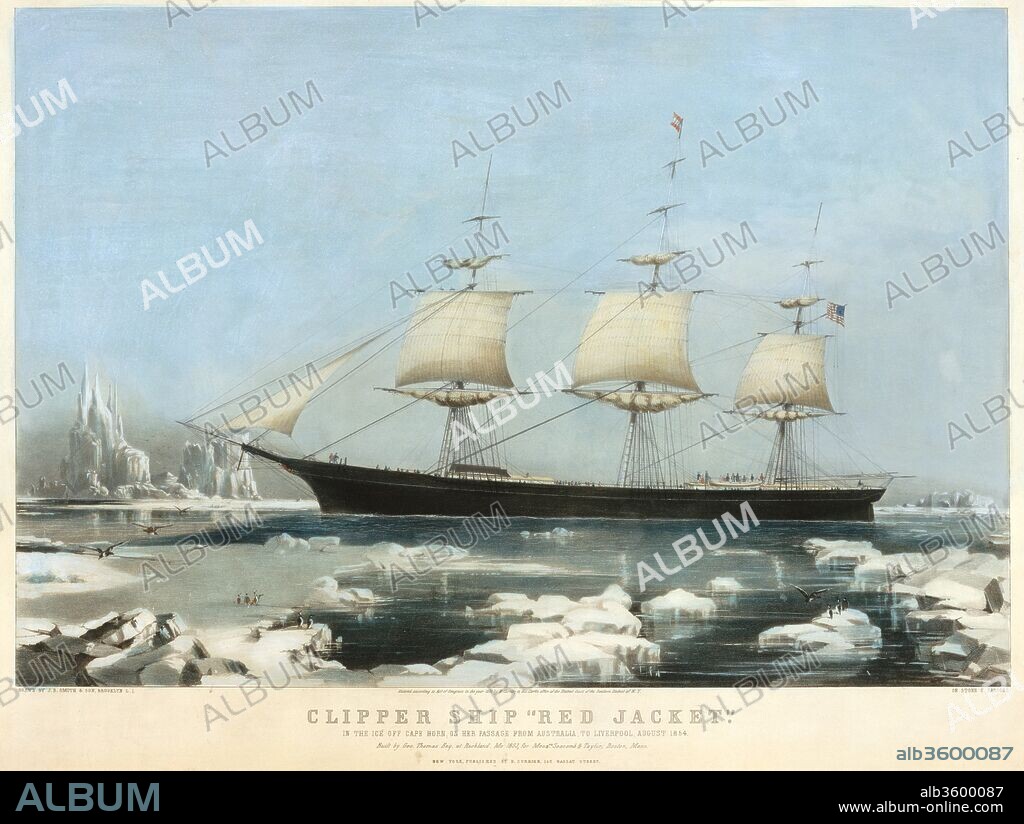alb3600087
CHARLES PARSONS, AFTER JOSEPH B. SMITH. Clipper Ship "Red Jacket"-In the Ice off Cape Horn, on Her Passage from Australia, to Liverpool, August 1854

|
Zu einem anderen Lightbox hinzufügen |
|
Zu einem anderen Lightbox hinzufügen |



Haben Sie bereits ein Konto? Anmelden
Sie haben kein Konto? Registrieren
Dieses Bild kaufen.
Nutzung auswählen:

Titel:
Clipper Ship "Red Jacket"-In the Ice off Cape Horn, on Her Passage from Australia, to Liverpool, August 1854
Untertitel:
Automatische Übersetzung: Klipper "Red Jacket" - im Eis vor Kap Hoorn, auf ihrer Passage von Australien nach Liverpool, August 1854. Künstler: Charles Parsons (Amerikaner (England geboren), Hampshire 1821-1910 New York); Nach Joseph B. Smith (Amerikanische, New York, 1798-1876). Abmessungen: Bild: 16 1/8 x 23 11/16 in. (41 × 60,1 cm) Blatt: 21 1/4 x 27 9/16 in. (54 × 70 cm). Herausgeber: Lithographiert und veröffentlicht von Nathaniel Currier (Amerikanische, Roxbury, Massachusetts 1813-1888 New York). Datum: 1855. ?Red Jacket? gehört zu den größten und schnellsten amerikanischen Klipperschiffen, die je gebaut wurden. Entworfen mit einem 255-Fuß-Deck von Samuel Hartt Pook aus Boston für die Eigentümer Seacombe und Taylor, wurde es von George Thomas in Rockland, Maine, gebaut, der es im November 1853 auf den Markt brachte. Der Name ?Red Jacket? bezieht sich auf Sa Go Ye Wat Ha ("der sie wach hält"), der große Seneca-Redner und Führer, der den Briten während der amerikanischen Revolution geholfen hatte und ihm seine britische rote Uniform und seinen Spitznamen einbrachte. Nach der Revolution setzte sich Sagoyewatha für den Frieden ein, wurde ein Verteidiger der Kultur der amerikanischen Ureinwohner und ein Sprecher der Irokesen-Konföderation im Jahr 1792, als er Irokesen-Häuptlinge nach Philadelphia führte, wo sie sich bereit erklärten, im Grenzkrieg zu vermitteln. Während des Krieges von 1812 kämpfte Sagoyewatha mit den Amerikanern gegen die Briten. Im Januar 1854 unternahm die ?Red Jacket? ihre erste Reise von New York über den Nordatlantik nach Liverpool, England, wo ein neuer britischer Eigner sie für den australischen Einwanderer- und Frachttransport ausrüstete. Im Mai 1854 charterte die White Star Line das Schiff, um nach Melbourne, Australien, zu segeln, wo es nach 69 Tagen mit ungefähr 450 Passagieren (16 davon in Kabinen der ersten Klasse) ankam ? der zweitschnellste Rekord zu dieser Zeit. 1855 veröffentlichte Nathaniel Currier diesen Druck, der die ?Red Jacket? mitten auf ihrer Rückreise darstellt, als sie vier Tage lang in einem Eisfeld vor Kap Hoorn gefangen war. Die Route umfasste das Umsegeln von Kap Hoorn an der Spitze Südamerikas, wo zu bestimmten Jahreszeiten heftige Winde, große Wellen und aus der Antarktis treibende Eisberge und Eisschollen die Meere zwischen dem Südpazifik und dem Südatlantik tückisch für die Navigation machten. Trotz dieser Verspätung erreichte das Schiff mit all seinen Passagieren und einer wertvollen Goldladung ? Berichten zufolge etwa 45.000 Unzen ? Liverpool in 73 Tagen. Die Geschwindigkeit dieses Klippers wurde zu einem Verkaufsargument für zukünftige Passagiere; "Red Jacket" transportierte bis in die frühen 1860er Jahre Passagiere und Fracht zwischen England und Australien hin und her.
Clipper Ship "Red Jacket" - In the Ice off Cape Horn, on Her Passage from Australia, to Liverpool, August 1854. Artist: Charles Parsons (American (born England), Hampshire 1821-1910 New York); After Joseph B. Smith (American, New York, 1798-1876). Dimensions: Image: 16 1/8 × 23 11/16 in. (41 × 60.1 cm)
Sheet: 21 1/4 × 27 9/16 in. (54 × 70 cm). Publisher: Lithographed and published by Nathaniel Currier (American, Roxbury, Massachusetts 1813-1888 New York). Date: 1855.
"Red Jacket" ranks among the largest and fastest American clipper ships ever built. Designed with a 255-foot deck by Boston-based Samuel Hartt Pook for the owners Seacombe and Taylor, it was built by George Thomas in Rockland, Maine, who launched it in November 1853. The name "Red Jacket" refers to Sa Go Ye Wat Ha, ("he who keeps them awake"), the great Seneca orator and leader who had aided the British during the American Revolution, earning him his British red uniform and nickname. After the Revolution, Sagoyewatha championed peace, became a defender of native American culture and a spokesman for the Iroquois confederacy in 1792, when he led Iroquois chiefs to Philadelphia, where they agreed to mediate in frontier war. During the War of 1812, Sagoyewatha fought with the Americans against the British.
In January 1854, "Red Jacket" made her first voyage from New York across the north Atlantic to Liverpool, England, where a new British owner outfitted her for Australian immigrant and cargo transport. In May 1854, the White Star Line chartered the ship to sail to Melbourne, Australia, where it arrived after sixty-nine days with approximately 450 passengers (16 of them traveling in first class cabins) -- the second fastest record at that time. In 1855, Nathaniel Currier published this print depicting the "Red Jacket" in the midst of its return journey, when it was trapped for four days in an ice field off Cape Horn. The route involved sailing round Cape Horn at the tip of South America, where, at certain times of the year, fierce winds, large waves and icebergs and ice floes floating from Antartica made the seas between the South Pacific and South Atlantic treacherous to navigate. Despite this delay, the ship reached Liverpool in seventy-three days with all its passengers and a valuable gold cargo -- reportedly about 45,000 ounces. This clipper's speed became a selling point to future passengers; "Red Jacket" continued to transport passengers and cargo back and forth between England and Australia until the early 1860s.
Technik/Material:
hand-colored lithograph
Museum:
Metropolitan Museum of Art, New York, USA
Verleger:
Lithographed and published by Nathaniel Currier (American, Roxbury, Massachusetts 1813-1888 New York)
Bildnachweis:
Album / Metropolitan Museum of Art, NY
Freigaben (Releases):
Model: Nein - Eigentum: Nein
Rechtefragen?
Rechtefragen?
Bildgröße:
4200 x 3164 px | 38.0 MB
Druckgröße:
35.6 x 26.8 cm | 14.0 x 10.5 in (300 dpi)
Schlüsselwörter:
 Pinterest
Pinterest Twitter
Twitter Facebook
Facebook Link kopieren
Link kopieren Email
Email
